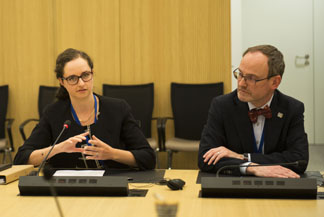On the 7 June 2022, the NATO International Military Staff (IMS) hosted their fourth Deep Dive Session focusing on the nexus between the Gender Perspective, and Emerging and Disruptive Technologies (EDT), specifically artificial intelligence (AI). This session discussed operationalising the Principles of Responsible Use for developing trust and fool proof interoperability stressing the importance of creating more reputable data for AI design with the integration of gender perspective. The presentations were given by Dr Ulf Ehlert, Head of Strategy and Policy at the NATO Science and Technology Organization and Zoe Stanley-Lockman from the Innovation Unit of the NATO Emerging Security Challenges Division.
<!—->
Values-Based Emerging and Disruptive Technologies
Dr Ehlert led the discussion by diving in to the topics of innovation, technology, and values. He noted that technological areas must “co-evolve with society in a process of mutual adaptation, we all play various roles in shaping its development but its outcome cannot and is not pre-determined”. On EDT, he noted the differences between “emerging” and “disruptive”. Emerging technology is driven by a recent scientific discovery or nascent technological development, that is expected to mature in the next 20 years and whose ultimate effects on defence, security and/or enterprise functions are yet uncertain. Therefore, it is a question of maturity. Whereas disruptive technology is a scientific discovery or technological development that is expected to have a revolutionary effect on defence, security and/or enterprise functions in the next 20 years, which is more of a question on impact. NATO should adopt evolutionary policy-making that builds on current knowledge, but also remains flexible enough so that today’s decisions can be adjusted or amended in the future. For more information on this, please refer to Dr Ehlert’s article on why our values should drive our technology choices.
Gender Perspective and AI

Ms. Zoe Stanley-Lockman presented more specifically on the intersection between the gender perspective and AI. She noted that there have been three waves of AI, which have focused, respectively, on handcrafted knowledge, statistical learning, and contextual adaptation. The Moravec’s Paradox demonstrates that for AI, high-level reasoning requires very little computation but low-level skills require more resources. Ms. Stanley-Lockman added that “it is easy to have your AI determine which national park one is in by a picture but more difficult for it to identify if there is a bird present”. AI systems do not mimic human logic therefore, we cannot expect to explain all the decisions that AI takes. For the intersection with the gender perspective, one of the problems that exists is the bias in design decisions. A way to mitigate the bias is by asking the questions: what problem are we trying to solve, what value is the AI system creating, what data can we use, who will be using the AI system. She gave some examples of the gender bias in regards to the percentage of women in image results for common jobs differing from reality, and translation software assigning gender roles to gender-neutral language. These biases can have adverse impacts for NATO if we do not address them. For example, if we train AI systems on unrepresentative data, we may develop unpredictable performances in real-world situations.
So what for NATO?
NATO’s AI strategy (2021) is centred on building responsible-by-design AI. Nations have agreed to six Principles of Responsible Use for AI which are: lawfulness, responsibility and accountability, explainability and traceability, reliability, governability, and bias mitigation. Design decisions for AI must start before the initial development in order to properly integrate a gender perspective. For more information, please refer to NATO’s Summary of the NATO Artificial Intelligence Strategy. NATO has established itself as a driving force in responsible innovation therefore it is strategically necessary. Additionally, following these principles provides operational value. With bias mitigation as one of NATO’s six core principles, the Alliance is set to incorporate a gender perspective into the development of AI-enabled capabilities, as well as the robustness of AI systems against attacks. As EDT and AI will be considered tools to scale and accelerate military decision-making, then NATO must ensure that they do not scale biased outcomes.
from WordPress https://ift.tt/nk91Kip
via IFTTT



No comments:
Post a Comment